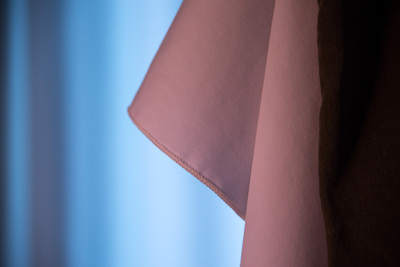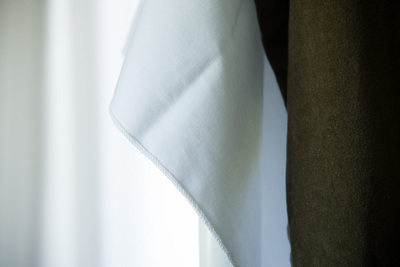What is White?
I’ve spent a lot of time over the last couple of days writing very long posts about how I’m going to one day show an image that I want to write about. The digression started when I made this image:

White on White
and wanted to talk about it.
I made this photo in my studio, on a pretty evening in a few days ago. It appears to show a dusky-pink triangular fabric draped in front of a blue wavy background. There’s a dark rectangular shape on the right.
Now, here’s approximately the same scene, made just a few minutes ago (around lunchtime).

WoW Redux
Both photographs were made with available natural window light. Here’s a hint as to why they appear differently — reread when I said I made the pictures. Right. One was a “pretty evening” and the other was “around lunchtime”. This is the same room, and the same setup, but very different effects.
Photographers deal with this sort of color variation-but-not all the time. It’s why we say seemingly nonsensical things about fluorescent lights looking green or old-fashioned light bulbs looking yellow, or LED lights looking blue, when to you, it just looks like light. Most of the time, your eyes and brain make adjustments so a white tablecloth hung in front of a white curtain looks… white.1
You can practice seeing the color of light by going to a big box store and looking at their light bulb aisle. There’s probably some display that shows various color-temperature lights, with lots of numbers that really don’t make any sense. These are all “white” lights, and which you buy for your lamps will mostly depend on your budget and personal taste.
But a camera isn’t evolved (yet!) to account for variations in the light color, so it has to use math. The camera in your phone “sees” the evening light as pink and will adjust its settings to compensate for it, so the photo you get is the one you (think you) see. This is called “white balance” and for most phone cameras it isn’t adjustable by the user. My BGC2 will do it also, if I tell it to, but I prefer to control that portion of my image-making.
White balance manipulation is a tool used in crafting an image. Most people have emotional associations with color (personal and cultural), and as a photographer I want to be able to tap into that to make the image relevant to the viewer.3
“But how, Barbara,” I can hear you saying, “how come the two whites in the evening photograph are so different, but in the noon photograph they’re the same?”
Well, my studio has two windows, one facing northeast, the other northwest. In the near-sunset evening, the northeast window is shaded, and the light from it appears bluish. The northwest window has sunlight coming through it, and will give a rosy hue to anything it lights up. The draped tablecloth in the foreground is being lit by the northwest window, while the background curtain is on the northeast window. At noontime, neither window gets direct sun, and so the color of the light is more or less the same from both.
-
Do you remember That Dress from a few months ago that had people talking about whether it was blue or white? I perceived it to be blue and black, though with some attention, I could “force” it to appear white and gold. ↩
-
Big Girl Camera ↩
-
Even with black and white photos, but that’s a topic for another day. ↩